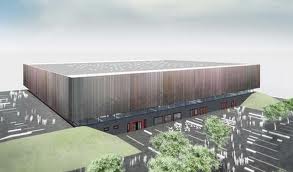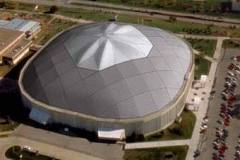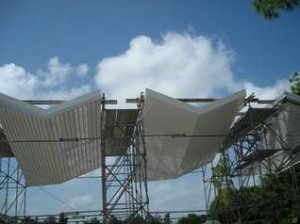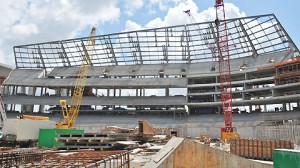Archive for the ‘Stadium Roofs’ Category
Sports Arena Roof Wins Architecture Award
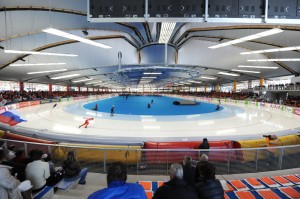 Winter sports fans in Germany are proud to be the home of an award winning stadium. The Speedskating Stadium Inzell, in Germany, won the 2011 World Architecture Award for its sporty roof. The stadium’s new roof earned the award for its unique design and innovative structure.
Winter sports fans in Germany are proud to be the home of an award winning stadium. The Speedskating Stadium Inzell, in Germany, won the 2011 World Architecture Award for its sporty roof. The stadium’s new roof earned the award for its unique design and innovative structure.
A Dazzling Design
Once an open air track, the stadium’s roof now covers the ice skating track without the use of interior columns, a first of its kind. The roof offers spectators an uninterrupted view of the surrounding mountains by boasting a continuous glass facade. From the outside, the roof looks like a cloud perching over the building’s sides. The roof was shaped to help the retain the track’s low temperatures for ideal skating conditions.
The stadium’s roof also includes large north-facing skylights, which make use of the limited winter daylight. The skylights are part of a green roofing initiative intended to reduce reliance on artificial lighting, efforts that are much appreciated in such a large arena. The roof materials also consist of a membrane that reflects the cold air from the ice back towards the track to create a thermal effect. Nearly 7,000 spectators can enjoy watching their favorite sport in this first-class facility thanks to the innovative efforts of Behnisch Architekten.
New Zealand Stadium gets Transparent Roof
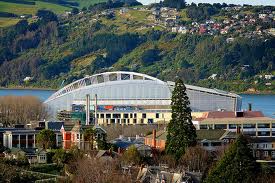
The largest transparent polymer or plastic covered structure in the Southern Hemisphere was recently completed at the Forsyth Barr stadium, in Dunedin New Zealand. The clear ethylene tetrafluoroethylene material was originally developed by the space industry. The 7.7 acre clear roof allows grass to grow inside the enclosed arena while protecting the fans from the elements.
The stadium was completed on time and on budget in time for the Rugby World Cup tournament. The ETFE (ethylene tetrafluoroethylene) covers the roof and part of the facades allowing maximum sunlight and fresh air onto the field. “The new roof means we can maintain a constant temperature and grow a stronger grass which will not become boggy because it will never rain, snow, or hail inside the stadium during a game at Forsyth Barr.” Said Ron Van Sluijs, project architect of Forsyth Barr stadium.
The stadium will be New Zealand’s largest indoor venue able to seat 30,000 fans. The first rugby game will be held on August 7, 2011, the North Otago vs. West Coast 2011 Heartland Championship. Elton John plans to perform a concert on November 25, 2011. 20,000 permanent and 11,000 temporary seats are angled allowing spectators to be closer to the action.
Construction began in June 2009 by Local firm Jasmax and the architecture firm Populous designed the Forsyth Barr stadium.
Repairs Under Way for Metrodome Roof
Work began Thursday to replace the storm damaged Minneapolis Metrodome roof. Although the Vikings continue to push for a new stadium, repairs will be made to the 29 year old fiberglass roof. The roof collapsed in December 2010 from the weight of snow during a blizzard.
The insurer, Affiliated FM will pay a total of $22.7 million for the damage to the roof. The roof will be replaced as the tears are too extensive and cannot be repaired. Birdair Inc., a New York contractor was hired by the Metropolitan Sports Facilities Commission to replace the roof.
A tarp was spread over the playing field Thursday to protect the turf that was replaced last year. Monday the crew will inspect the clamping for the roof panels, the panels may be installed as soon as next week. The center panels are due to be replaced first.
Birdair will be paid $18 million to complete the job by August 1st just in time for Minnesota Vikings preseason games. The original Metrodome was built for $68 million. Birdair designed and installed the roof that covered the dome in 1982.
The new roof materials will be similar to the original roof but will be lower than the first one. The outer layer fabric membrane received the first of its kind Energy Star rating. Helping to reduce roof temperatures and heat absorption, reducing cooling demand by approximately 10-15%. The roof’s inner liner will decrease echoes and improve the sound quality inside the facility. Monthly meetings will be held to discuss the ongoing roof project.
2012 Olympics Copper Topped Arena
The new 7,000 seat handball arena for the 2012 Summer Olympic games in London is due to receive a new copper roof. Construction on the roof recently finished and is now being wrapped in 3,000 square meters of mostly recycled and sustainable sourced copper. The cladding is due to be completed by the end of 2010.
The arena includes 88 rooftop “sun pipes” that reflect sunlight onto the field of play. Photo sensor lights come on when the sunlight fades or disappears during the daytime. The sun pipes were designed to switch off in cases such as a broadcast to be filmed during a live game. The estimated saving on lighting costs and energy usage are up to 40%.
The new arena has also incorporated a rainwater harvesting system. By collecting the roof’s water, and reusing it for the plants and lawns, reducing waste by an estimated 40%.
When the Olympics are over the arena can be adapted to become a multipurpose venue for community use. The retractable seating allows for more versatility for athletic training and public events.
Buckingham Group Contracting in Stowe, Bucks is building the arena and expects to be completed by early 2011. The roofing, copper cladding and sun pipes were completed by IRC Carocelle based in Walsall.
Storm Tears University of Phoenix Roof
A thunderstorm with high winds damaged the roof of the University of Phoenix Stadium (home to the NFL’s Arizona Cardinals and the Tostitos Fiesta bowl) in Glendale Arizona this past Thursday.
The winds caused a piece of outer metal skin to flip up and puncture the white canvas like fabric that stretches across the retractable roofs steel girders. The holes allowed water and debris to fall onto the stadium floor. No one has reported being injured from the falling debris.
Stadium officials are still assessing the damage and how much repairs will cost. The Cardinals are set to open their preseason game at home against Houston on August 14th.
Iowa's UNI-Dome Repairs
Workers have begun repairs on the dome roof at the University of Northern Iowa in Cedar falls. The stainless steel roof was seriously damaged about a year ago during a wind and hail storm. The project is expected to be completed by October said the contractors at Schwickert’s of Mankato, Minn.
University officials decided to replace the stainless steel with polyvinyl chloride or PVC, the new membrane will make the roof look white, just like the original roof prior to 1994. Once the PVC is in place it will be covered with the same material that topped the stainless steel dome. The new PVC roof comes
with a 30 year warranty and annual inspections.
The project is expected to cost $1.8 million to repair. Officials were originally told it would be $4.3 million to replace the stainless steal roof.
FEMA will help the university cover the $100,000 deductible and Traveler’s Insurance Company will pay for the new roof.
The domes original air inflated canvas roof was replaced with the stainless steel after it was severely damaged in a December 1994 snow storm.
Sneak Peak at Red Sox Roof
3 mock up panels of the roof for the new Boston Red Sox spring training stadium are perched high on scaffolding in the adjacent lot. The mock up panels are the same design from the drawings and are on display for approval by the Red Sox and Lee County.
Kraft construction assembled the panels and will be the firm that will build the $80 million spring training complex. The ballparks seating capacity will be 11,000 and is expected to be completed in time for the spring training in 2012.
The facility will be built on Daniels Parkway in Ft. Myers Florida near the Southwest Florida International Airport. Ft. Myers in Lee County has been home to the Boston Red Sox for spring training since 1993.
Marlins Stadium Retractable Roof
Florida Marlins stadium in Miami scheduled to open in April 2012 will have the nation’s first retractable roof earning the “Leadership in Energy and Design” certificate. The US Green Building Council has given credits for some of the stadiums environmentally friendly designs. In addition to the retractable roof, there will be 2 salt water aquariums behind home plate. Both will be 36 inches high, one is 34 feet long and will hold 600 gallons of water and the other is 24 feet long with 450 gallons of water. Both tanks will have bullet proof glass in front of and in back of the acrylic panels.
The stadium is in East Little Havana, in the same neighborhood as the former orange bowl. This $642 Million stadium will have 37,000 seats and about 1,000 designated standing room. Providing a comfortable environment keeping out the rain and extreme heat that have kept attendance low at the existing Sun Life Stadium.
You can see complete sketches and simulations of what to expect for the new stadium at the sales headquarters overlooking the construction site on NW 7th St. or you can view all stages of construction from the new ballpark webcam at mlb.com . The retractable roof construction will be the focus for the next 11 months.




